Scheme for Teaching Practice for Early Primary School
Added on 2023-01-05
36 Pages12465 Words66 Views
PROJECT INCLUDING
SCHEME OF WORK PLAN
AND LESSON PLAN
SCHEME OF WORK PLAN
AND LESSON PLAN
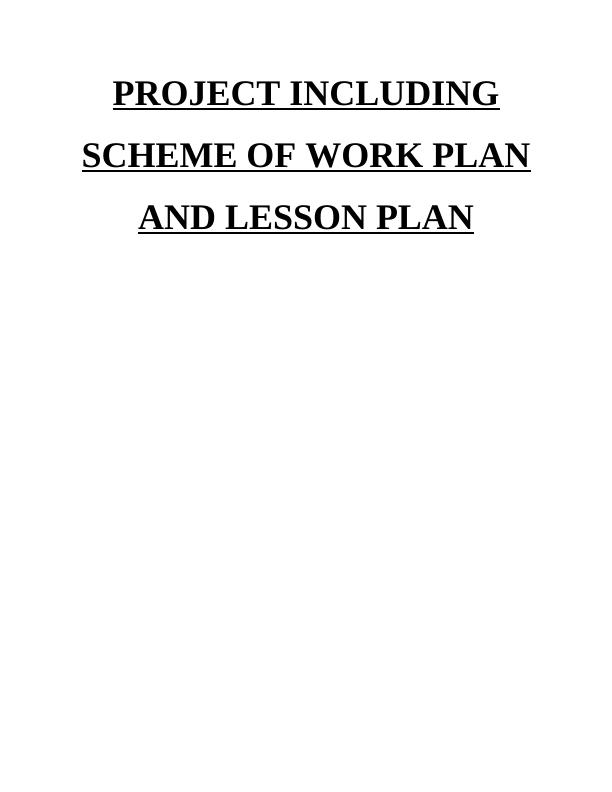
TABLE OF CONTENTS
TASK 1............................................................................................................................................4
Analyze own role andresponsibilities in education and training as teacher................................4
B) Summarize key aspects of legislation, regulatoryrequirementsand codes of practice relating
to own areas of teaching, education and training........................................................................4
TASK 2............................................................................................................................................6
Analysis of roles and methods of initial and diagnostic assessment in agreeing at individual
learning goals with the learners...................................................................................................6
b Identifying the reason of meet their individual need of learning..............................................8
c Presenting the point of referral for learners help......................................................................8
TASK 3............................................................................................................................................9
Schemes for Teaching Practice for Early Primary School..........................................................9
TASK 4..........................................................................................................................................14
Lesson Plan for Maths...............................................................................................................14
Lesson Plan 1: Topic: Number and place value........................................................................15
Lesson Plan 2: Topic: Addition and subtraction........................................................................15
Lesson Plan for English.............................................................................................................16
Lesson Plan 3: Topic: Grammar and Punctuation.....................................................................16
Lesson Plan 4: Topic: Spelling..................................................................................................17
Self-evaluation lesson plan 1:....................................................................................................18
Self-evaluation lesson plan 2:....................................................................................................18
Self-evaluation lesson plan 3:....................................................................................................19
Self-evaluation lesson plan 4:....................................................................................................20
TASK 6..........................................................................................................................................20
a. Analysing various principles of assessment..........................................................................20
TASK 1............................................................................................................................................4
Analyze own role andresponsibilities in education and training as teacher................................4
B) Summarize key aspects of legislation, regulatoryrequirementsand codes of practice relating
to own areas of teaching, education and training........................................................................4
TASK 2............................................................................................................................................6
Analysis of roles and methods of initial and diagnostic assessment in agreeing at individual
learning goals with the learners...................................................................................................6
b Identifying the reason of meet their individual need of learning..............................................8
c Presenting the point of referral for learners help......................................................................8
TASK 3............................................................................................................................................9
Schemes for Teaching Practice for Early Primary School..........................................................9
TASK 4..........................................................................................................................................14
Lesson Plan for Maths...............................................................................................................14
Lesson Plan 1: Topic: Number and place value........................................................................15
Lesson Plan 2: Topic: Addition and subtraction........................................................................15
Lesson Plan for English.............................................................................................................16
Lesson Plan 3: Topic: Grammar and Punctuation.....................................................................16
Lesson Plan 4: Topic: Spelling..................................................................................................17
Self-evaluation lesson plan 1:....................................................................................................18
Self-evaluation lesson plan 2:....................................................................................................18
Self-evaluation lesson plan 3:....................................................................................................19
Self-evaluation lesson plan 4:....................................................................................................20
TASK 6..........................................................................................................................................20
a. Analysing various principles of assessment..........................................................................20
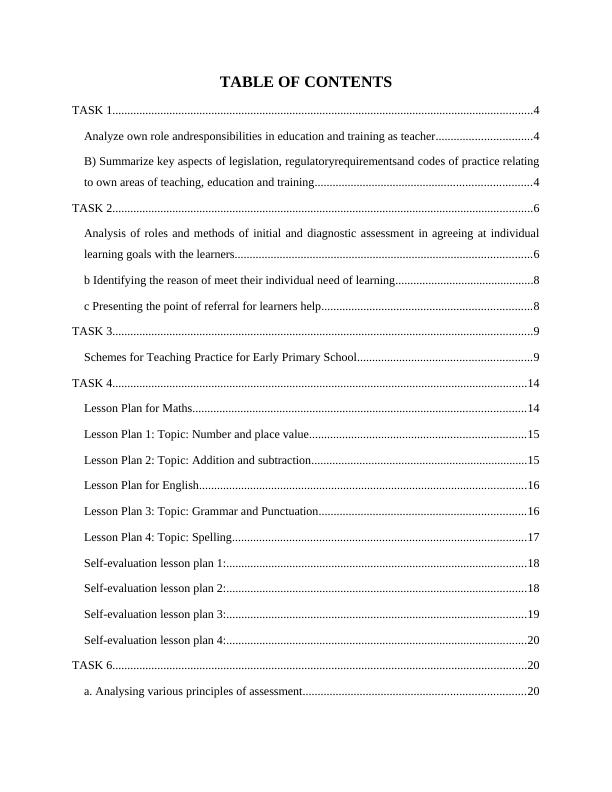
b. Different methods of assessment...........................................................................................22
c. Effectiveness of assessment types on different learners........................................................25
TASK 7..........................................................................................................................................26
a. Demonstration of core elements............................................................................................26
b. Benefits and limitations of communication methods............................................................27
TASK 8..........................................................................................................................................29
Reflection of the teaching practice in different areas................................................................29
REFRENCES.................................................................................................................................32
c. Effectiveness of assessment types on different learners........................................................25
TASK 7..........................................................................................................................................26
a. Demonstration of core elements............................................................................................26
b. Benefits and limitations of communication methods............................................................27
TASK 8..........................................................................................................................................29
Reflection of the teaching practice in different areas................................................................29
REFRENCES.................................................................................................................................32

TASK 1
Analyze own role andresponsibilities in education and training as teacher
Own role and responsibility as a teacher
As a teacher I should have ability to plan, prepare and delivers lessons to the participants.
I must have knowledge to teach students on the basis of national curriculum guidelines within
my specialist subject area. I should have ability to encourage student to participate in lessons and
other school activities (Ottesen and Møller, 2016). I should have good leadership skills so that
can support other team members to implement school’s development plan in effective manner. I
should have good communication skill that is one of prime demand by primary school because
there are various students who do not have good ability to communicate with teachers or due to
miscommunication unable to share their views to the student. So, it is highly essential for the me
as teacher to have good communication skills then I can effectively access and reports on the
students’ behavior. It is primary role teacher to taking part in opportunity to boost own learning
with the support of continuous development program. So, I should have this ability as well.
These all abilities posses by my so I can be good teacher in primary school.
Analyze relationships and boundaries between teaching roles and other professional roles
It is important for the teacher to have ability to build good relationship and limits
between teaching roles and other professional roles. For example professionalism needs to
maintain a systematic standards and meets own responsibility to learners. It is gained by setting
professionals and personal boundaries helps to be clear about limitation and own professional
role which involves. For example,teachers always be in their professionalism manner while
building good relationship with students and never shares their personal information to the
studentto get personally because it reflects negative impact on other students. So, it is essential
for the teachers to treat all students equally and should avoid to touch with students
inappropriately.
Analyze own role andresponsibilities in education and training as teacher
Own role and responsibility as a teacher
As a teacher I should have ability to plan, prepare and delivers lessons to the participants.
I must have knowledge to teach students on the basis of national curriculum guidelines within
my specialist subject area. I should have ability to encourage student to participate in lessons and
other school activities (Ottesen and Møller, 2016). I should have good leadership skills so that
can support other team members to implement school’s development plan in effective manner. I
should have good communication skill that is one of prime demand by primary school because
there are various students who do not have good ability to communicate with teachers or due to
miscommunication unable to share their views to the student. So, it is highly essential for the me
as teacher to have good communication skills then I can effectively access and reports on the
students’ behavior. It is primary role teacher to taking part in opportunity to boost own learning
with the support of continuous development program. So, I should have this ability as well.
These all abilities posses by my so I can be good teacher in primary school.
Analyze relationships and boundaries between teaching roles and other professional roles
It is important for the teacher to have ability to build good relationship and limits
between teaching roles and other professional roles. For example professionalism needs to
maintain a systematic standards and meets own responsibility to learners. It is gained by setting
professionals and personal boundaries helps to be clear about limitation and own professional
role which involves. For example,teachers always be in their professionalism manner while
building good relationship with students and never shares their personal information to the
studentto get personally because it reflects negative impact on other students. So, it is essential
for the teachers to treat all students equally and should avoid to touch with students
inappropriately.

B) Summarize key aspects of legislation, regulatoryrequirementsand codes of practice relating to
own areas of teaching, education and training
A teacher is like a pacemaker and a great example for the student so it is essential for the
teacher to follow all key aspects of legislation and code of practice related to teaching and
learning. For example, I should not abuse or discriminate any student physically and mentally in
the primary school. I should respect them and have followed a course planned before teaching in
class and dress properly. While codes practice is a set of written rules and regulation which
explains that how individuals work in the professions and teacher musty behave (Johari, Tanand
Zulkarnain, 2018). I should ensure that I meet al criteria towards the professional learning which
have already sated by governed bodies, develops more skills and expand my knowledge as good
professional teacher. Thus, I will follow all rules related to my teaching profession before
teaching primary school’s students.
. Ways to promote appropriate behaviour and respect for others
It is the responsibility of a teacher to ensure that a positive environment is maintained in
class where all the students behaves in a good manner with each other and also with teachers.
The responsibility of this totally lies in the hand of teachers as they are the role model for
students whose path they follow. In my opinion, a teacher can follow various ways to inculcate
the good behaviour and a sense of respect among each other which are as follows:
I myself believes in talking with the students politely as they learn from the teachers. So,
I realized that whenever I talk to the students with complete politeness and respect, they
also behave in the same manner with each other and with me.
I become a good listener whenever any conflicts arise. I do not listen one person and
takes an effective decision which do not hurt any of them. I listen and respond effectively
to the opinions of all rather than being biased for some (Chinwendu and Shedrack, 2018).
I establish certain routines in which the students do not get confused and perform their
responsibilities effectively which do not lead to conflicts and bad behaviour.
I also ensure that the learning environment is also tidy, suitable and safe. I do not create
such environment in class which forces the students to misbehave with each other in
order to progress.
own areas of teaching, education and training
A teacher is like a pacemaker and a great example for the student so it is essential for the
teacher to follow all key aspects of legislation and code of practice related to teaching and
learning. For example, I should not abuse or discriminate any student physically and mentally in
the primary school. I should respect them and have followed a course planned before teaching in
class and dress properly. While codes practice is a set of written rules and regulation which
explains that how individuals work in the professions and teacher musty behave (Johari, Tanand
Zulkarnain, 2018). I should ensure that I meet al criteria towards the professional learning which
have already sated by governed bodies, develops more skills and expand my knowledge as good
professional teacher. Thus, I will follow all rules related to my teaching profession before
teaching primary school’s students.
. Ways to promote appropriate behaviour and respect for others
It is the responsibility of a teacher to ensure that a positive environment is maintained in
class where all the students behaves in a good manner with each other and also with teachers.
The responsibility of this totally lies in the hand of teachers as they are the role model for
students whose path they follow. In my opinion, a teacher can follow various ways to inculcate
the good behaviour and a sense of respect among each other which are as follows:
I myself believes in talking with the students politely as they learn from the teachers. So,
I realized that whenever I talk to the students with complete politeness and respect, they
also behave in the same manner with each other and with me.
I become a good listener whenever any conflicts arise. I do not listen one person and
takes an effective decision which do not hurt any of them. I listen and respond effectively
to the opinions of all rather than being biased for some (Chinwendu and Shedrack, 2018).
I establish certain routines in which the students do not get confused and perform their
responsibilities effectively which do not lead to conflicts and bad behaviour.
I also ensure that the learning environment is also tidy, suitable and safe. I do not create
such environment in class which forces the students to misbehave with each other in
order to progress.

I also maintain up to date records which do not get me and the students confused. This
creates a sense of confidence in me that helps me in expressing my points which forces
the students to respect me (Yassine, Tipton‐Fisler and Katic, 2020).
d. Promoting equality and diversity in teaching practice
The students in a classroom comes from different backgrounds and culture. So this is the
foremost responsibility of the teacher to implement the equality and diversity practices in the
teaching:
I treat all the students fairly and equally irrespective of the background, culture and the
family.
I actively promote multiculturalism in the lessons I teach which forces the children to
value the culture of each other (Palacios, 2016).
I try to use most of the resources in my teaching methods with the multicultural themes.
I plan the lessons which helps in reflecting the diversity in the classroom.
I do not discriminate anyone on the basis of race, caste, gender and any other aspects.
I give equal opportunities to all the students and motivate all of them to participate in all
activities.
I set the clear rules regarding to the fact that how everybody should be treated.
I avoid using the stereotypes in the examples I give in the teaching lessons and also in the
resources (Ylöstalo, 2016).
I strive hard to create an all-inclusive culture for the staff and students.
I use variety of teaching and assessment methods which creates an environment of
innovation and creativity.
I ensure that I follow all the policies and procedures in the learning materials which do
not promote discrimination on any basis.
creates a sense of confidence in me that helps me in expressing my points which forces
the students to respect me (Yassine, Tipton‐Fisler and Katic, 2020).
d. Promoting equality and diversity in teaching practice
The students in a classroom comes from different backgrounds and culture. So this is the
foremost responsibility of the teacher to implement the equality and diversity practices in the
teaching:
I treat all the students fairly and equally irrespective of the background, culture and the
family.
I actively promote multiculturalism in the lessons I teach which forces the children to
value the culture of each other (Palacios, 2016).
I try to use most of the resources in my teaching methods with the multicultural themes.
I plan the lessons which helps in reflecting the diversity in the classroom.
I do not discriminate anyone on the basis of race, caste, gender and any other aspects.
I give equal opportunities to all the students and motivate all of them to participate in all
activities.
I set the clear rules regarding to the fact that how everybody should be treated.
I avoid using the stereotypes in the examples I give in the teaching lessons and also in the
resources (Ylöstalo, 2016).
I strive hard to create an all-inclusive culture for the staff and students.
I use variety of teaching and assessment methods which creates an environment of
innovation and creativity.
I ensure that I follow all the policies and procedures in the learning materials which do
not promote discrimination on any basis.
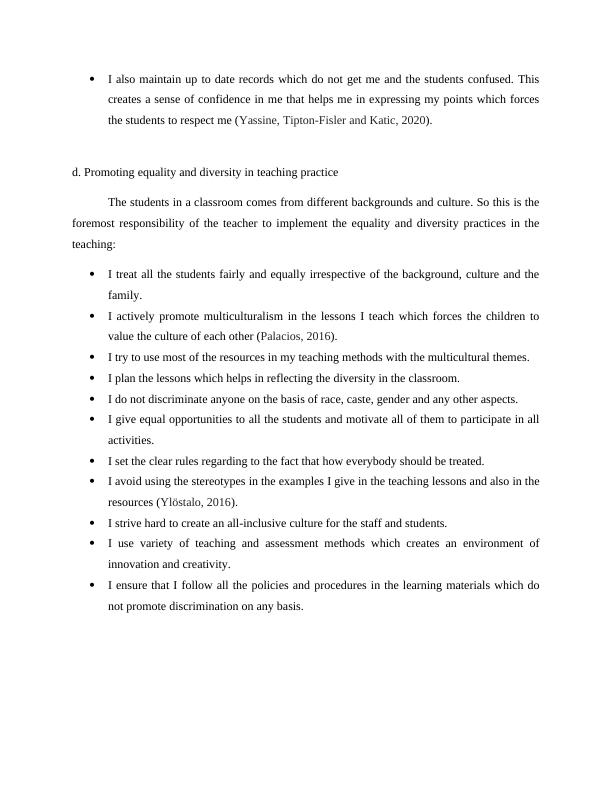
TASK 2
Analysis of roles and methods of initial and diagnostic assessment in agreeing at individual
learning goals with the learners
For a learner the most important thing is to have proper knowledge of the initial and diagnostic
assessment for agreeing at the individual learning goals for the personal learning and
development. If the learner is not having the required initial assessment then they will not be able
to set the goals for themselves. The initial assessment provides a basis to the student that where
the student must begin with their learning (Kesler, 2019). This is essential because of the reason
that there are many different types of ways in which a person can set the goals for their learning
and personal development, but it is confusing as to the fact that which method to be used for the
development and setting up of goals. Hence, for this the initial assessment and the diagnostic
assessment is very essential for agreeing to the individual learning goals. The diagnostic
assessment is a concept which is related with the specific skill that need to be possessed by the
teacher as for baseline of the student and set the learning goals on the basis of the strength and
weakness of the student. Further on the basis of the information collected for the diagnostic plan
the collected information can further be used in developing a plan for the student to learn and
develop new and effective skills.
The use of initial and diagnostic assessment is closely related to one another and for this it is
essential for the learner to make effective use of both the initial and diagnostic assessment. The
method or process through which it can be implemented by the learner in enhancing the goals
and learning style by them includes the following process-
Firstly the student must personalise their learning by analysing the strength and weakness
of the person.
Further after the analysis of the strength and weakness it is the duty of the teacher or
person involved in development of student to make and develop an individual learning
plan.
Further the next step for the person is to begin the process of the assessment and continue
with the plan which is being planned by the teacher or responsible person.
Analysis of roles and methods of initial and diagnostic assessment in agreeing at individual
learning goals with the learners
For a learner the most important thing is to have proper knowledge of the initial and diagnostic
assessment for agreeing at the individual learning goals for the personal learning and
development. If the learner is not having the required initial assessment then they will not be able
to set the goals for themselves. The initial assessment provides a basis to the student that where
the student must begin with their learning (Kesler, 2019). This is essential because of the reason
that there are many different types of ways in which a person can set the goals for their learning
and personal development, but it is confusing as to the fact that which method to be used for the
development and setting up of goals. Hence, for this the initial assessment and the diagnostic
assessment is very essential for agreeing to the individual learning goals. The diagnostic
assessment is a concept which is related with the specific skill that need to be possessed by the
teacher as for baseline of the student and set the learning goals on the basis of the strength and
weakness of the student. Further on the basis of the information collected for the diagnostic plan
the collected information can further be used in developing a plan for the student to learn and
develop new and effective skills.
The use of initial and diagnostic assessment is closely related to one another and for this it is
essential for the learner to make effective use of both the initial and diagnostic assessment. The
method or process through which it can be implemented by the learner in enhancing the goals
and learning style by them includes the following process-
Firstly the student must personalise their learning by analysing the strength and weakness
of the person.
Further after the analysis of the strength and weakness it is the duty of the teacher or
person involved in development of student to make and develop an individual learning
plan.
Further the next step for the person is to begin the process of the assessment and continue
with the plan which is being planned by the teacher or responsible person.
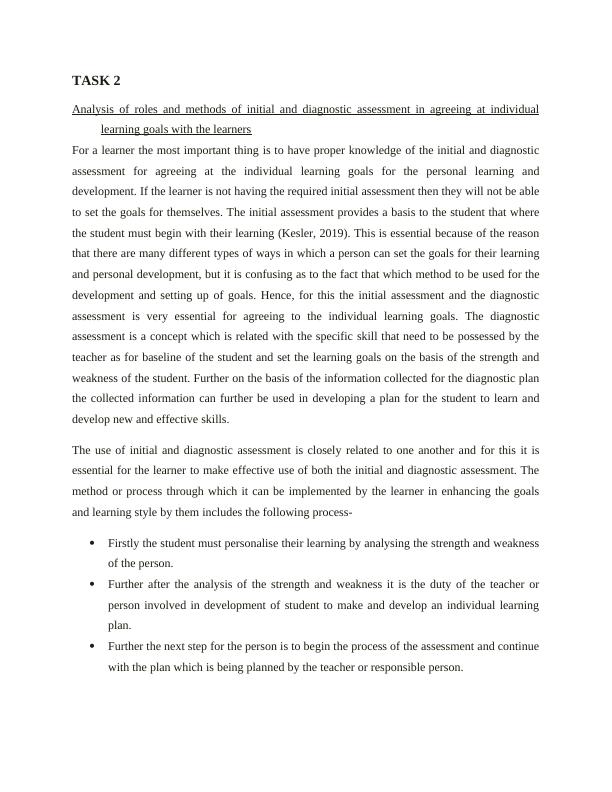
In the end the last stage is to monitor and recheck that whether the student is doing or
learning as per the plan made or not. This is essential as this will assist the person in
developing more effectively for the purpose of learning and developing oneself.
Further there are many different types of methods with which the initial and diagnostic
assessment can be conducted (Hunter and Brown, 2018). These methods generally includes
documenting, self- assessment, discussion, use of various types of assessment tools, observation,
structured activities and many other different types of methods. All these method assist the
person in developing and working in the direction of attaining the goals of the person which are
set for self development and growth.
For example if student has already a plan that they have to develop their communication skill
then it will be easier for them to work on improving it.
b Identifying the reason of meet their individual need of learning
It is quite necessary to determine the individual needs and meet the same by learners
because it boost their morale and also encourages them. In addition to this, there are some cases
where the learner do not gain much when the study is performing with a mass instruction. That is
why, if a teacher provides individually prescribe instruction (IPI) then it actually assist learners
to understand as well as grasping the educational concepts. Moreover, by identifying the need of
a learner will help to exactly deliver the same need. In the primary education school, education is
a crucial to the success of an individual in their adult life and that is why, there is need to
understand the need of a learner and then provide the same.
In addition to this, it is also analyzed that a learner have their own individual learning
need and teacher adapting their best ways in order to meet the define aim. For example, teacher
in the primary education classes, tries to promote the safe environment and always tries to
minimize the difficulties in order to meet the define aim. Also, by identify the need, teachers’
tries to increase the self- esteem and motivate their employees in order to cope up with any
challenges. Zhang and et.al., (2018) also stated that need of a learner clearly represented the gap
between what a student wants to get out from learning program and their current state of
knowledge. That is why, there is a need to determine the exact need so that teacher may take
necessary action that during the class- room practices and tries to provide best learning by
adopting preferred learning styles. For example, during session, through conversation with
learning as per the plan made or not. This is essential as this will assist the person in
developing more effectively for the purpose of learning and developing oneself.
Further there are many different types of methods with which the initial and diagnostic
assessment can be conducted (Hunter and Brown, 2018). These methods generally includes
documenting, self- assessment, discussion, use of various types of assessment tools, observation,
structured activities and many other different types of methods. All these method assist the
person in developing and working in the direction of attaining the goals of the person which are
set for self development and growth.
For example if student has already a plan that they have to develop their communication skill
then it will be easier for them to work on improving it.
b Identifying the reason of meet their individual need of learning
It is quite necessary to determine the individual needs and meet the same by learners
because it boost their morale and also encourages them. In addition to this, there are some cases
where the learner do not gain much when the study is performing with a mass instruction. That is
why, if a teacher provides individually prescribe instruction (IPI) then it actually assist learners
to understand as well as grasping the educational concepts. Moreover, by identifying the need of
a learner will help to exactly deliver the same need. In the primary education school, education is
a crucial to the success of an individual in their adult life and that is why, there is need to
understand the need of a learner and then provide the same.
In addition to this, it is also analyzed that a learner have their own individual learning
need and teacher adapting their best ways in order to meet the define aim. For example, teacher
in the primary education classes, tries to promote the safe environment and always tries to
minimize the difficulties in order to meet the define aim. Also, by identify the need, teachers’
tries to increase the self- esteem and motivate their employees in order to cope up with any
challenges. Zhang and et.al., (2018) also stated that need of a learner clearly represented the gap
between what a student wants to get out from learning program and their current state of
knowledge. That is why, there is a need to determine the exact need so that teacher may take
necessary action that during the class- room practices and tries to provide best learning by
adopting preferred learning styles. For example, during session, through conversation with
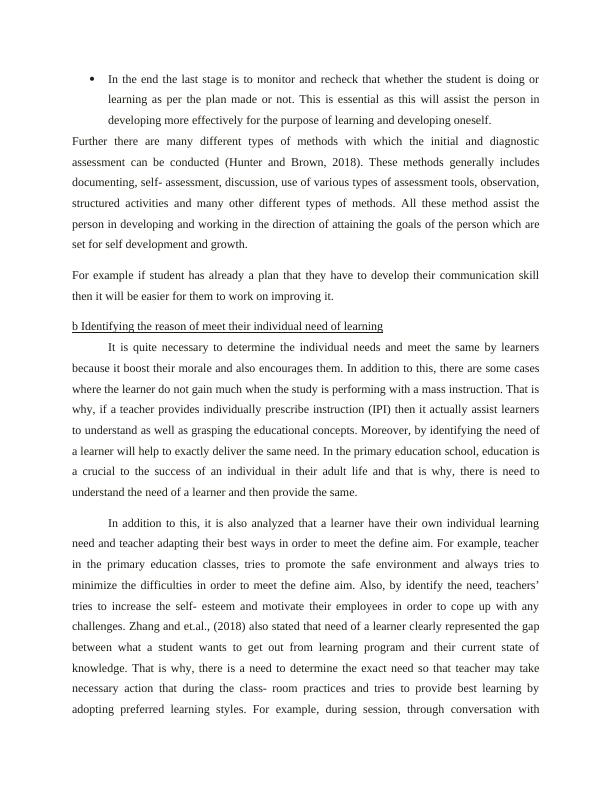
End of preview
Want to access all the pages? Upload your documents or become a member.
Related Documents
Roles and Responsibilities of a Teacher in Education and Traininglg...
|40
|8194
|317
Understanding of Roles, Responsibilities and Relationship in Training and Educationlg...
|28
|10315
|1
Teaching, Learning and Assessment in Education and Traininglg...
|13
|3957
|424
Teaching, Learning, and Assessment in Education and Traininglg...
|23
|8863
|91
Teaching, Learning and Assessment in Education and Training : Reportlg...
|34
|8981
|55
Teaching, Learning and Assessment in Education and Traininglg...
|22
|8001
|18
